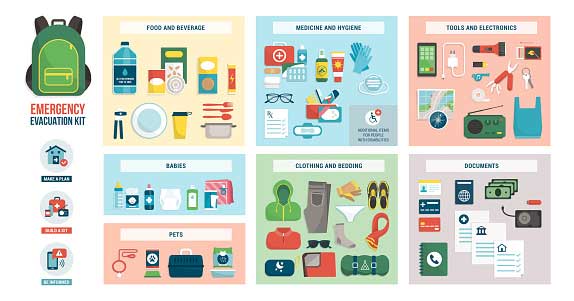2018 was a record year for natural disasters, and 2019 is off to a rocky start. Wildfires in the West, floods and tornadoes in the Midwest and hurricanes along the East and Gulf coasts cost billions of dollars in damage. But the monetary figures tell only part of the story.
If you’re a homesteader, a natural disaster can rob you of not only your home, but also your livelihood if you live off the land. In the blink of an eye, everything you’ve worked for can wash away or go up in smoke. Preparing in advance can help you pick up the pieces should the unthinkable occur.
1. Know Your Risks
Where you live determines your risk of natural disasters. A hurricane is unlikely to strike a farmhouse in Iowa, but a tornado, fire or flood could destroy property and claim lives all the same. Evaluating your risks is the first step in preparation.
For example, if you’re in a flood zone, your homeowner’s insurance probably doesn’t cover this type of damage. You will need to purchase separate flood insurance to cover yourself. Be aware if you live in an area of high wildfire risk. Even areas not prone to flooding can experience mudslides if such disasters decimate foliage that normally holds soil intact.
2. Ready Emergency Go-Bags
If the devastating Camp Fire taught us anything, it’s when seconds count, there’s no time to pack. Prepare a go-bag for yourself and each family member. Include the following.
- Water: One gallon per person per day. You can keep these jugs in your vehicle, since they also come in handy in case of breakdowns.
- Food: At least three days’ worth. It can take several days for food to reach emergency evacuation shelters.
- Medications: Ask your doctor to prescribe a week’s worth to keep in your vehicle in case of evacuation.
- Flashlights, radio and extra batteries: Finding light or operating electricity is uncertain. Make sure you have a stash of flashlights, extra batteries and a hand-crank radio.
- Cellphone and backup charger: If family members are at work or school, you need a way to get in touch — this is one time a dead phone represents a crisis.
- Dust mask and plastic sheets: In case of fire or storms, air quality may plummet. This scenario can prove dangerous even to those without respiratory conditions like asthma. Plastic sheets double as raincoats and emergency shelter in a pinch.

3. Plan to Evacuate or Free Pets and Livestock
If you have large numbers of livestock, you may not have time to transport them. But don’t leave them to perish — give them a chance by setting them free. If they’re unbranded, use non-toxic spray paint to write your name and phone number on prized animals.
Keep pet carriers ready during wildfire and hurricane season. Soft carriers work better for temperamental pets like cats who often balk at plastic carriers. A 10-gallon tote with a lid containing a small aerator can transport aquarium fish in a pinch.
4. Practice Your Drills
If a fire breaks out at your home, you don’t have time to coach your 8-year-old how to climb from his two-story window down the escape ladder. Rehearse your evacuation route with friends and family at least once every few months.
Designate meetup areas if family members are away or become separated during flight. Write your phone number in indelible ink on the tags of young children’s clothing so rescuers can contact you if a non-verbal child becomes lost in the chaos.
5. Secure Your Home for Staying or Going
Take common-sense measures to protect your home, even if you must flee. In fire areas, clear brush and debris away from homes. In flood areas, fill sandbags and place them around areas of ingress. If you lack hurricane shutters, hammer boards over windows in case severe storms strike.
If evacuating, locate shutoffs for electricity, gas, etc. in advance. Depending how much notice you have, crank refrigerator and freezer settings all the way up before cutting off power. If staying, locate an area away from windows like a basement or an enclosed interior bathroom to wait out the storm.
6. Review Warranty and Insurance Information
Carrying a home warranty and solid homeowner’s insurance policy can help you rebuild after a disaster. Additionally, whether you’re a DIY sort or hire contractors, keep copies of all paperwork containing warranty information. For example, if you’ve recently added a new custom garage door, replaced your roof or upgraded your windows, acts of God may or may not be included as part of the coverage.
Disasters damage documentation left in file cabinets, so invest in secure cloud storage and upload copies of all insurance and warranty paperwork. You can also rent a safety deposit box for relatively little expense at most major financial institutions.

7. Begin Rebuilding
Once the disaster passes, you’ll need to dig into the dirty work. Be sure to protect yourself with the proper supplies. You’ll want to wear a hard hat in case of falling debris, waterproof boots and safety gloves at a bare minimum.
Pace yourself as you clean up. Dealing with the aftermath of a disaster can overwhelm the heartiest souls. Take breaks not only for your body, but your spirit as well — stumbling across broken heirlooms takes an emotional toll.
Prepare and Rebuild From Disaster
There’s no way to eliminate the chances of your homestead suffering damage due to a natural disaster. However, with preparation, you can minimize the destruction and rebuild your life.










